Optimizing the poor performing CTR of your already well ranked, most important pages, without necessarily having to improve these pages rankings further -which in some cases can prove to be challenging for competitive queries- is probably one of the lowest hanging fruit when starting an SEO process of an established site, and it is one of those recurring activities to do through your SEO process -to maximize the results- once you start seeing rankings improvements, since in some cases, the improvement in clicks/traffic from optimizing your top pages CTR can be non-trivial and as impactful as improving in rankings.
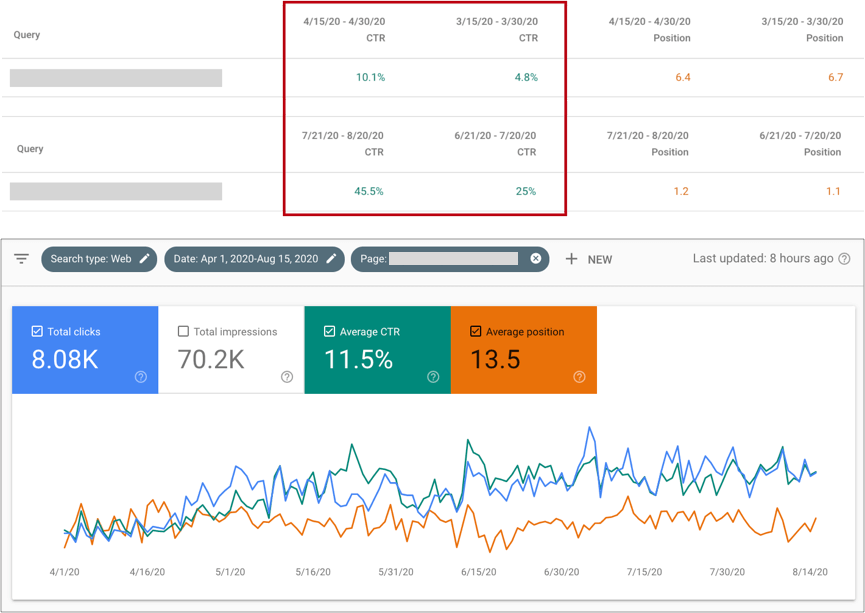
What to do to improve poor CTR in organic search results besides improving rankings? Let’s go through the different steps and main scenarios to focus on, described in the flowchart below!
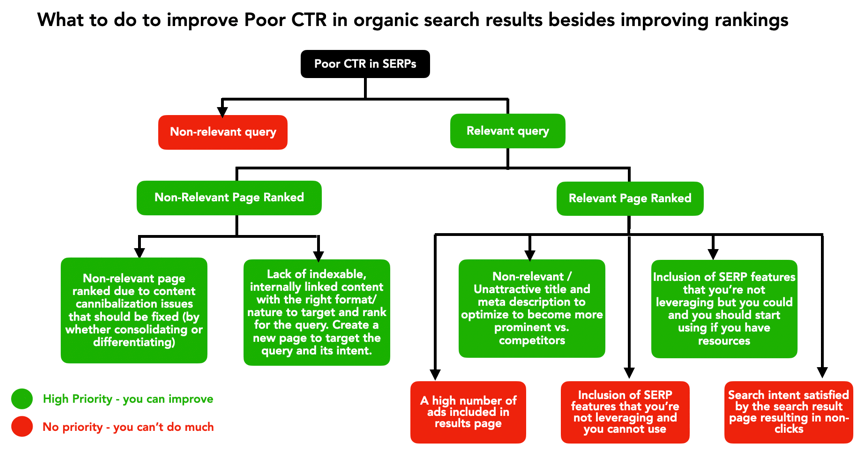
1. Get your top pages & queries CTR data and spot the poor performing ones for your meaningful queries
You can use the free Google Search Console Google Sheets Add-On to get your top pages along their ranked queries per device that will allow you to segment to better identify those pages with an underperforming CTR per device type, creating an independent list for each, to spot those with the highest impressions within the top 10 and poorer CTR.
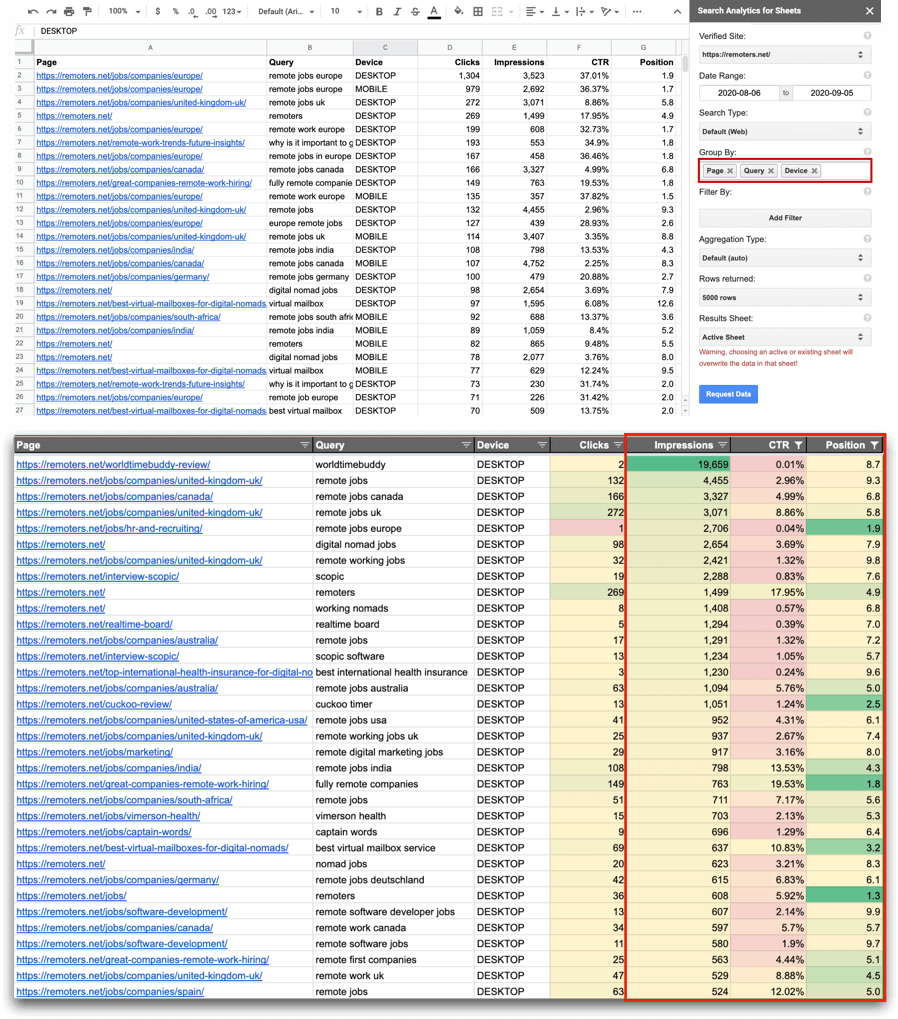
You can double check how you’re performing CTR wise by using the Advanced Web Ranking Google Organic CTR History per country/device/industry + search features to check how are yours performing in general vs. the average ones in your context.
You can also use tools like Ryte’s Search Success that connects with your Google Search Console and automatically identifies and report on your CTR underperforming queries.
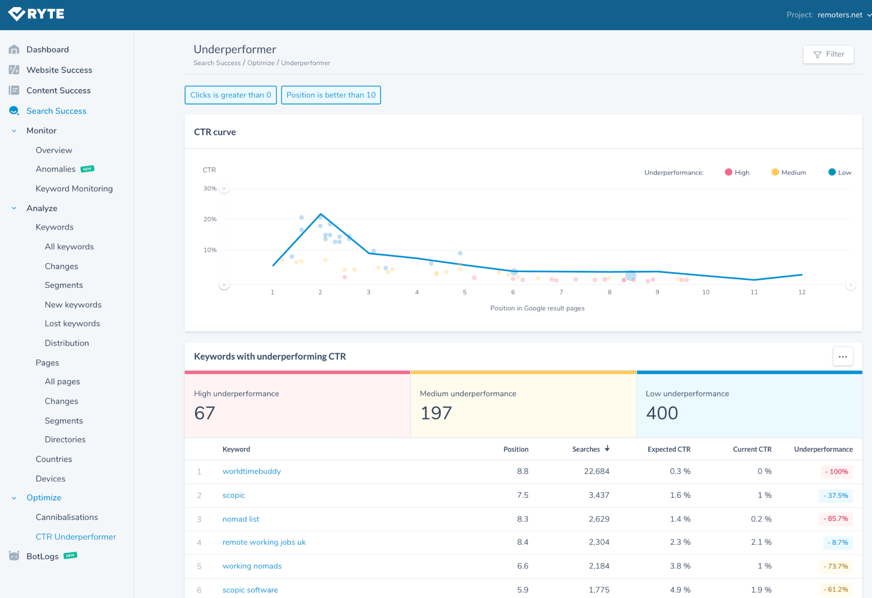
Once that you get those underperforming pages along their ranked queries, go through them to identify those ranking for meaningful queries towards your site offering/business -to avoid focusing on terms for which you don’t really want to rank for- and in which cases the ranked pages are the relevant ones -or not- to rank for meaningful queries, and categorize them as shown below.
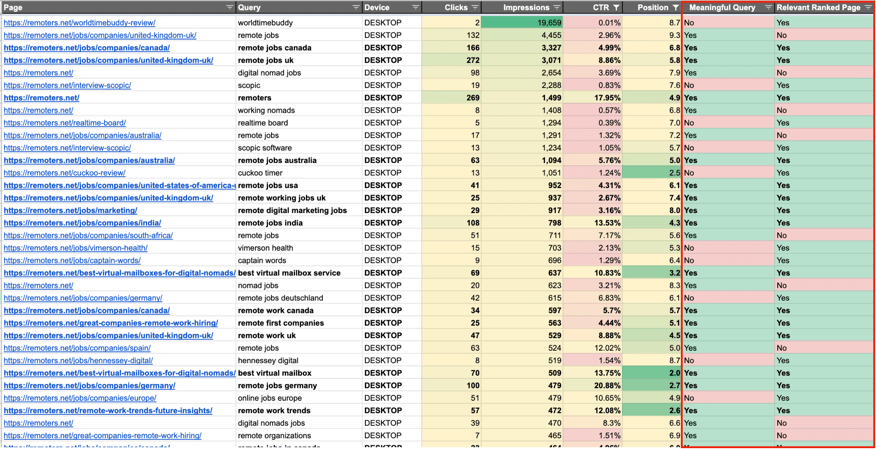
2. When the ranked page for your meaningful queries is the relevant one…
Let’s start with the “lowest hanging fruit” scenario: the one of already relevant pages ranking for meaningful queries.
In this case there can be unfortunately a few main reasons causing the low CTR for which you can’t do much to change (with your organically ranked pages):
- A high number of ads included in results page
- The query search intent is satisfied by the search result page resulting in non-clicks
- Inclusion of SERP features that you’re not leveraging but you cannot use whether due to lack of relevance to your specific scenario or lack of capacity to generate the content or required structured data following the specification, etc. for example, not being able to appear in local pack results since you don’t have a physical presence in that location.
We will see in the next sections the tools and features that can be used to identify search features opportunities as well as the number of ads shown in the SERPs that can negatively affect the CTR.
On the other hand, tools like SimilarWeb offer now the percentage of searches for a given query that result in non-clicks that we can use to verify those more informational / factual queries that tend to be the ones that end up in non-clicks searches and assess how worthy they are to focus on and prioritize to optimize or not their CTR.
It’s important to note how this behavior can differ a lot based on the query nature / intent, even for the same topic, for example, for “headphones”, “best headphones for gaming” or “wireless in ear headphones”:
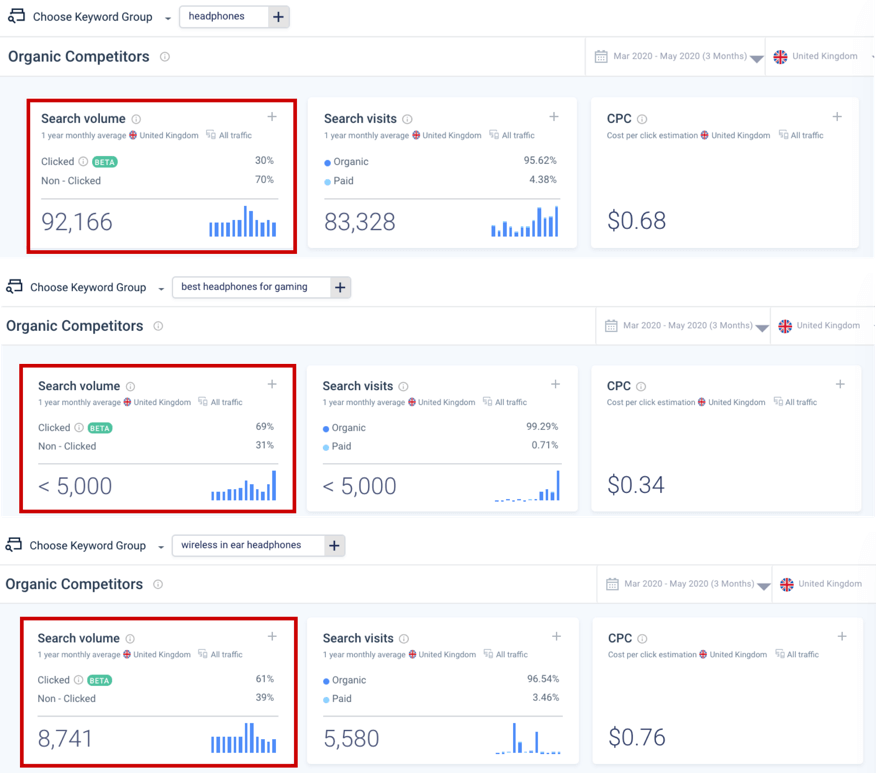
However, there are others scenarios for which you can optimize to improve the CTR:
- Non-relevant / unattractive title and meta description is shown and can be optimized to become more attractive vs. competitors
- Inclusion of SERP features (from rich results to featured snippets) that you’re not leveraging but you could and you should start if you have resources to do so
The best way to assess these is by analyzing the SERPs for these meaningful queries to categorize your results and decide which are the worthy ones to optimize. Let’s see how!
2.1. To identify and optimize non-relevant, non-attractive or truncated titles and meta descriptions
Use the ImportXML function (with =IMPORTXML(B2,”//title”) for the titles and =IMPORTXML(B2,”//meta[@name=‘description’]/@content”) for the meta descriptions) -or the freemium ImportFromWeb free extension to avoid some of the ImportXML limitations- to quickly get the current titles and meta descriptions of those top pages that you have identified are the relevant to rank for meaningful queries to asses their relevance, optimization and attractiveness.
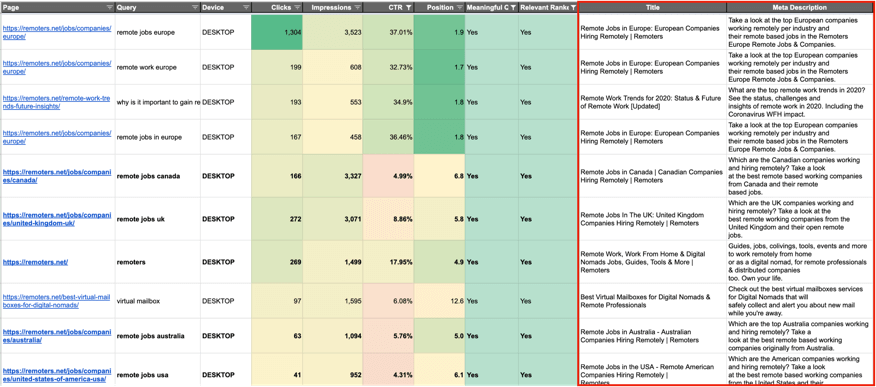
There will be cases in which the lack of relevance or optimization will be obvious, in others not so much, and for this you might want to also take at look at how your titles and meta descriptions are shown, if they’re truncated and how those other pages also ranking (especially those outranking you) in the same search results pages are featured, to identify potential gaps and opportunities vs. them.
For this you can use the Free SERP Analyzer (that you can see working here and copy from here) that I’ve created using Google sheets leveraging the ImportFromWeb free extension, to easily scrape the SERPs -for many of the queries at the same time if you want- and check the titles and meta descriptions of all the players ranking for the queries for which you’re looking to improve your CTR to identify opportunities.
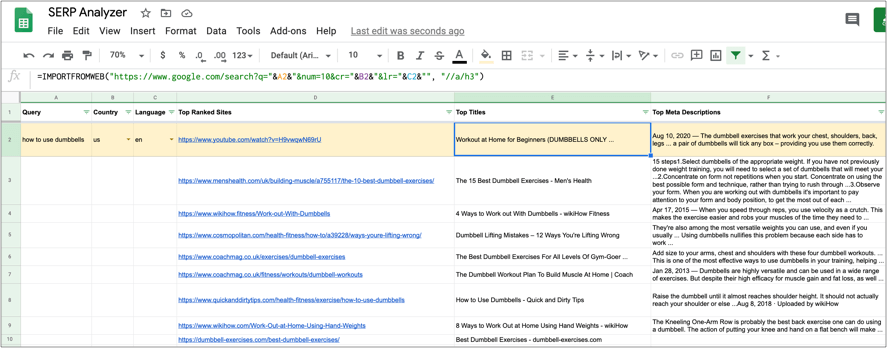
2.2. To identify Search Features opportunities that you’re not yet leveraging but you could
Look for the inclusion of Google’s Search features (from rich results triggered by the usage of structured data to featured snippets) that you’re not leveraging but you could if you already have the content -or you could easily start to- and you should start if you have resources.
To quickly identify SERP features opportunities for the set of queries that I want to improve my top pages CTR for I also use the Free SERP Analyzer (that you can copy and edit to personalize) in which I can also scrape the different types of SERP features -as well as ads- to see if they’re included or not in those particular search results pages and can see which are the websites already shown there:
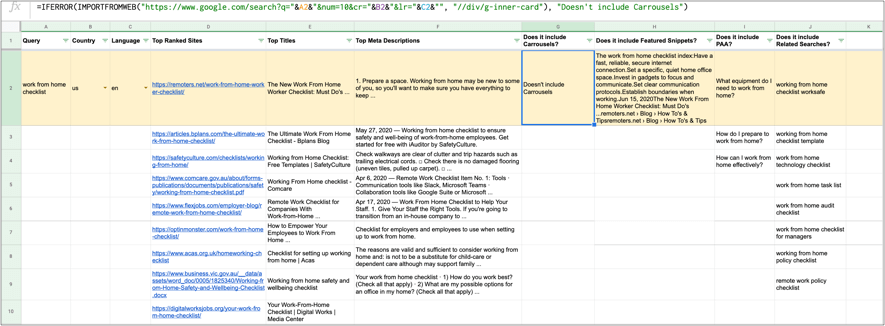
Then to make sure that I’m not missing anything out, and also check which are those search results also showing a very high share of ads, I like to use the SEMrush’s Bulk Keyword Analysis that allows to do a bulk validation for up to 100 keywords for any country at a time to see which are the SERP features included or them, as well as ads.
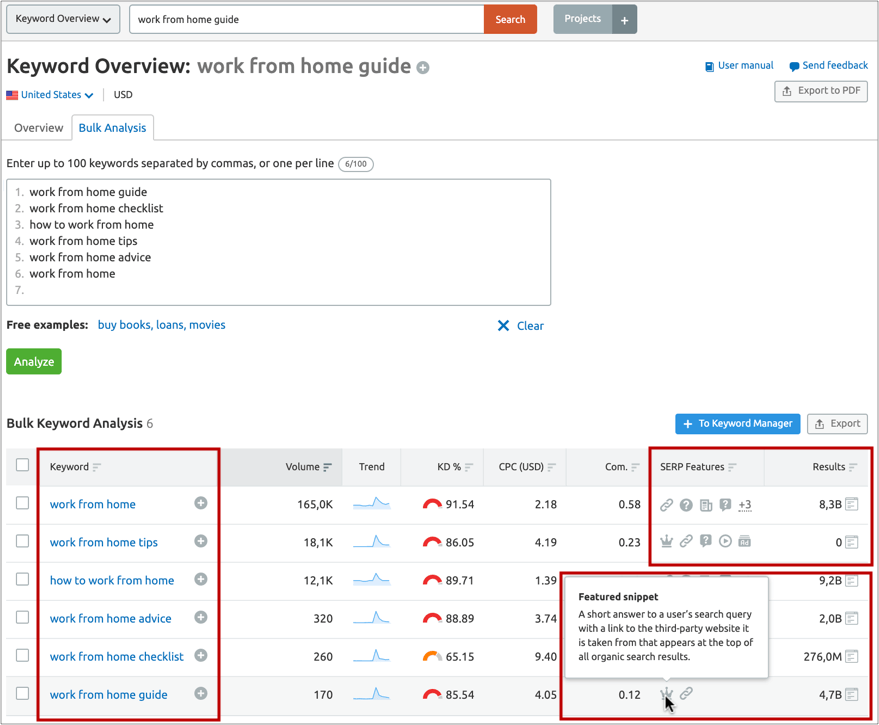
If you also want to directly double check you can just click on the results icon to see the stored SERP snapshot that they have for any of these queries to “visualize” the SERP features:
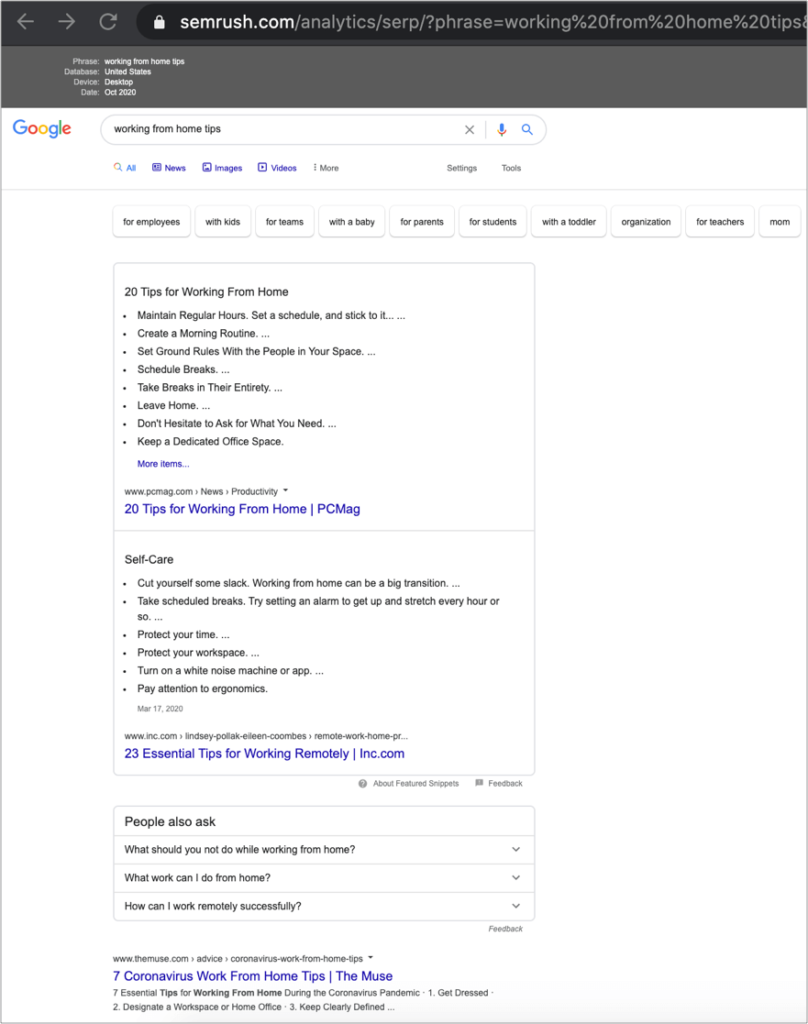
If you want to also check some of the SERPs in real time you can use the the SEOMinion Free Browser Extension that allows (among many other handy SEO validations) to simulate the search results for any country and language, and if you want you can check how the SERP looks in two countries at a time, to scan through the search results pages of these queries.
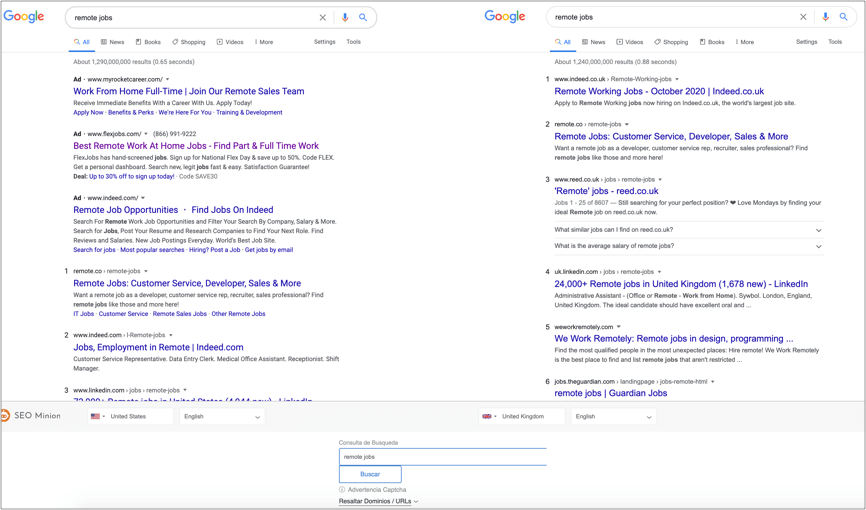
Assess if you already have content or not for the identified SERP features and the level of effort required to start being featured. In some cases, like for featured snippets, it could be quick changes to your already existing informational pages by adding a TOC at the start of your blog posts or guides or by improving their structure and usage of headings.
For example, it took me a few hours to optimize the “Work from Home Checklist” in Remoters.net that wasn’t initially being included with a featured snippet at the top to start being shown there, by following the steps above, as can be seen in the screenshots below.
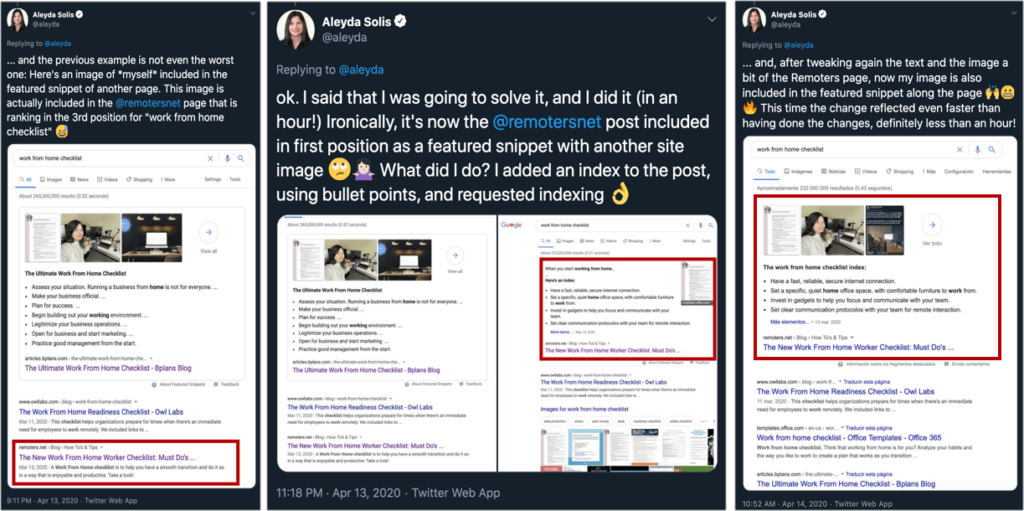
There might be other scenarios for which you’re not already included in a search feature since you’re not yet implementing the required structured data (for Articles, Videos, FAQs, How-To’s, etc.) or generating the content in the right format (Videos, Images, products feeds), or a combination of these. In this case you should assess the requirement for their particular inclusion (which Google’s has well documented here) and the level of effort that it will take you to implement them, putting it in context with the rest of your SEO process actions and efforts.
On the other hand, it might also be happening that you are already implementing the required content in the relevant format along the needed structured data, but this might be triggering issues which you can validate by doing a list crawl of your top pages shown in SERPs with search features in which you’re not yet included, with SEO crawlers that validate it, like Screaming Frog or Sitebulb which has a very handy report that directly shows you any syntax or technical related implementation errors or warnings -the same shown by Google- of those particular types that are meant to trigger search features.
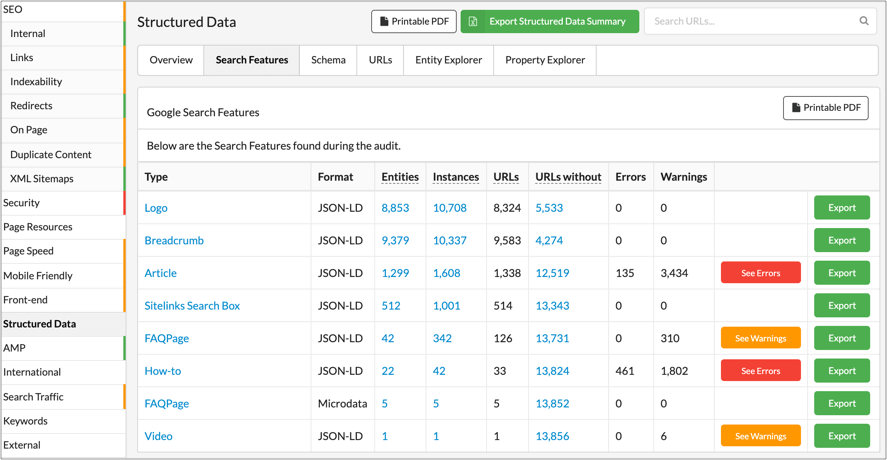
While you check for structured data technical implementation issues make sure to also verify that you’re complying with the relevant search features quality guidelines and check if you have received any “manual action” message over the Google Search Console for “spammy structured data” to take the relevant steps if so.
The goal should be to identify those search features that you can easily leverage with your existing top pages and whether start implementing or fix the implementation to start doing it so.
3. When the ranked page for your meaningful queries is a non-relevant one…
For those pages that are identified to not be relevant to target their ranked queries -which are meaningful for you to focus on-, there will tend to be two main scenarios:
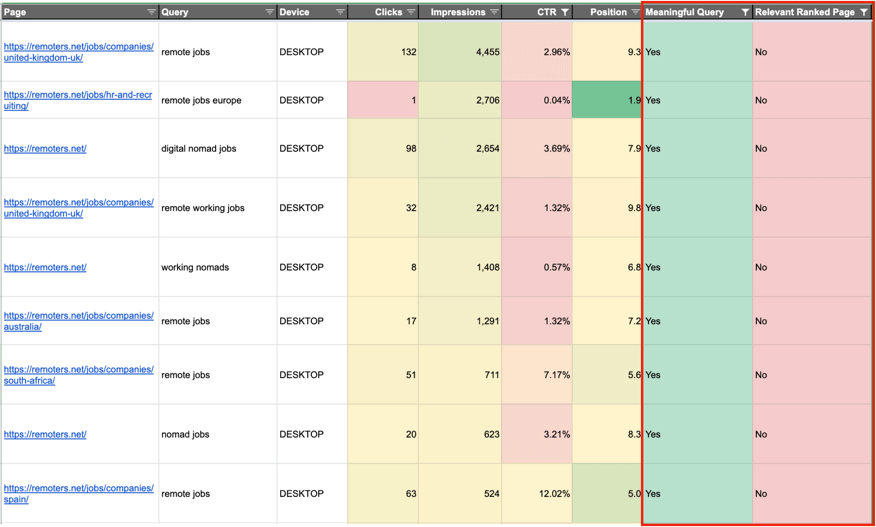
3.1. A non-relevant page is ranking due to cannibalization issues
In this scenario you identify that the page ranking for the targeted query is not the relevant one despite having another that is meant to rank for the query. There are two main alternatives in this case to fix the situation:
If the ranked page cannibalizing the relevant one is a duplicate, not-meant to be ranked URL…
Sometimes you can end up generating URLs which feature the exact same content than the meant to be ranked, “canonical” page; which due to a variety of reasons (backlinks, internal links, XML sitemap inclusion, etc.) end up outranking the meant to be ranked page.
Check if that’s the case and if so, then consolidate these pages that offer the same information, if possible by 301-redirecting -and if it’s not possible, using a canonical tag- to the “original” (canonical) meant to be indexed and ranked URL, making sure that the canonical one is indexable and correctly optimized towards the query, and any internal links and XML sitemaps are updated accordingly to refer towards it, fixing any issues that could have caused that the non-relevant URL was ranking.
If the ranked page cannibalizing the relevant one is meant to rank for a different meaningful query…
If the goal of the ranked page is to target a different query (maybe of a similar topic vs. the one for which is ranking, but different at the end of the day), you should then:
- Improve, differentiate and/or expand the ranked page content to better optimize it towards its own relevant query
- Revise the indexability, content relevance and internal linking of the meant to be ranked page towards the targeted query, so it can start ranking for it instead of the wrong one
3.2. A non-relevant page is ranking due to lack of indexable, well linked content in the right format to fulfill the query search intent
In this scenario a non-relevant page is ranking due the lack of an indexable, optimized page for the query. For example, the page ranking from Remoters for “remote only companies” is not really a page featuring “remote only companies”, and one could be created to better fulfill this query intent, showcasing them.
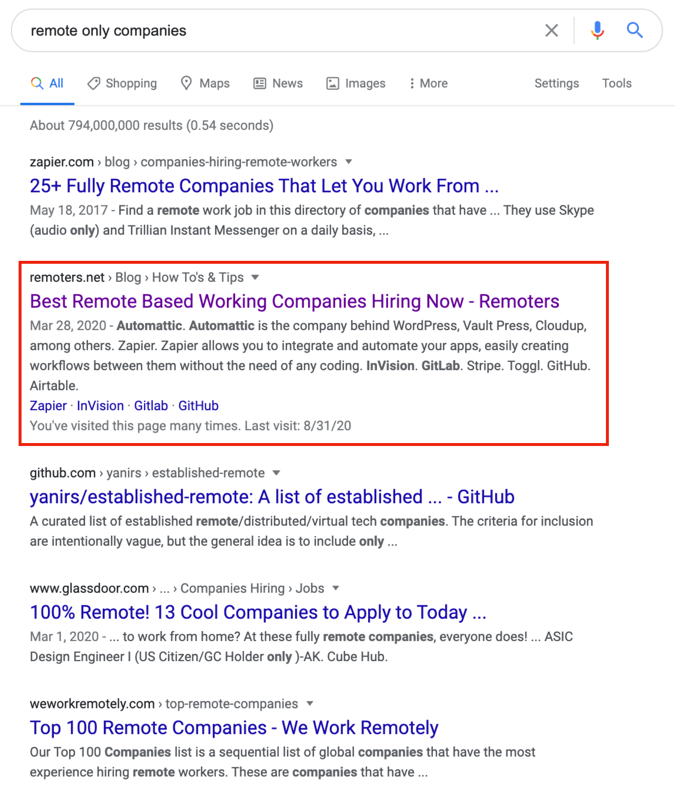
This would be worthy to do for meaningful and popular queries for which you have enough relevant information / products / services to feature in the page to create.
Wrapping up! It’s time to optimize your top pages CTRs in SERPs
I hope these flowchart, scenarios, steps and tools are useful for you to identify the worthy to leverage opportunities to improve your top pages with lower CTRs, saving you time and effort when going through the process. If you have any questions, doubts or any other scenarios, tools, ideas… leave them in the comments below!